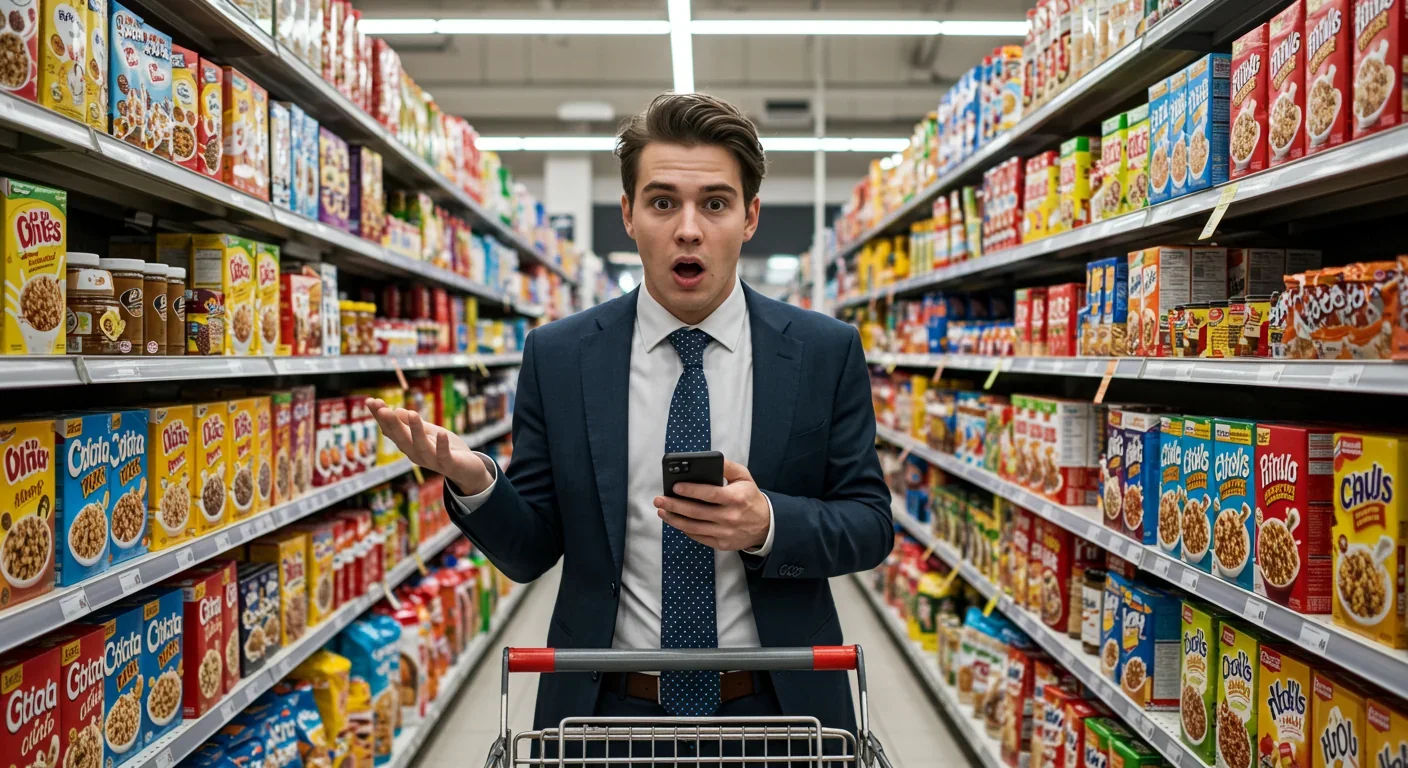Why Your Brain Is Hardwired to Lose Money

TL;DR: Modern life's endless options create decision paralysis and anxiety. Research shows that beyond a threshold, more choices decrease satisfaction. Practical strategies like satisficing, automation, and constraint help reclaim mental energy.

Imagine standing in a grocery store aisle, frozen. Not because you can't find what you need, but because you're facing 47 varieties of olive oil. Instead of feeling empowered by options, you feel drained. You grab one at random just to escape the cognitive load. Welcome to the paradox of choice, where freedom becomes a burden and possibility becomes paralysis.
By 2025, the average person switches screens every 47 seconds, making thousands of micro-decisions daily. From Netflix queues to career paths, we're drowning in options that promise fulfillment but often deliver anxiety instead. This isn't just about being indecisive—it's about how our brains respond when presented with an overwhelming buffet of choices.
Psychologist Barry Schwartz coined the term "paradox of choice" after noticing something counterintuitive: beyond a certain threshold, more options actually decrease satisfaction. His landmark research revealed that while some choice is essential for autonomy, too much creates three distinct problems: decision paralysis, reduced satisfaction with our choices, and escalating expectations that make contentment nearly impossible.
The mechanism is straightforward but powerful. When you have three options, you can evaluate them quickly. When you have 30, your brain has to work exponentially harder. Each additional option increases the cognitive load required to compare features, weigh trade-offs, and predict future regret. Eventually, your prefrontal cortex—responsible for complex decision-making—simply runs out of gas.
Dr. Gloria Mark's research identified this exhaustion as decision fatigue, a depleted state where your ability to make quality choices deteriorates. It's why you're more likely to pick the unhealthy snack at 8 p.m. than 8 a.m., even when your willpower seems fine. Your brain treated every screen switch, email notification, and dinner option as a mini-decision, and now there's nothing left in the tank.
The digital age has amplified this problem exponentially. Streaming services offer thousands of titles, dating apps present endless potential partners, and career websites list millions of job openings. Research on digital overload shows that this abundance doesn't just tire us out—it fundamentally changes how we approach decisions, shifting us from "good enough" to "perfect," a transition that rarely ends well.
Walk into any supermarket and you'll encounter what economists call overchoice. The jam study, one of psychology's most famous experiments, illustrated this beautifully. Researchers set up tasting booths offering either 6 or 24 jam varieties. The larger display attracted more browsers, but here's the twist: people who saw fewer options were 10 times more likely to actually buy something.
This pattern repeats across industries. E-commerce research reveals that every additional product option decreases conversion rates by roughly 2%. Online retailers with curated collections outperform those with massive catalogs, not despite having fewer options, but because of it. Choice overload doesn't just delay decisions—it prevents them entirely.
The clothing industry provides another telling example. Fast fashion brands release hundreds of new styles weekly, creating what psychologists call analysis paralysis. Shoppers spend hours comparing similar items, only to abandon their carts or return purchases at unprecedented rates. One study found that 30% of online clothing returns stem not from product defects but from buyer's remorse fueled by wondering if another option would have been better.
Even mundane purchases become exhausting. Buying toothpaste now requires decisions about whitening level, sensitivity, flavor, organic ingredients, and packaging sustainability. What should take 10 seconds becomes a research project. Marketing research shows that brands offering fewer, clearly differentiated products see higher customer satisfaction and loyalty—people appreciate boundaries.
The paradox intensifies when stakes rise. Career decisions, once constrained by geography and available industries, now span the globe across thousands of job categories. A recent study on career decision-making found that college graduates spend an average of 6 months longer exploring options than they did a decade ago, yet report lower satisfaction with their eventual choices.
Remote work exploded this phenomenon. Suddenly you're not limited to companies within commuting distance—you could work for a Berlin startup from Bangkok or join a San Francisco tech giant while living in Lisbon. This global marketplace sounds liberating until you're comparing hundreds of opportunities, each with different cultures, time zones, and growth trajectories. The decision becomes paralyzing.
Mid-career professionals face similar struggles with skill development. Online learning platforms offer 200,000+ courses. Which programming language should you learn? Which certification matters? You could study data science, UX design, product management, or digital marketing—all have promising futures. Career counselors report that clients increasingly suffer from "FOMO career syndrome," constantly second-guessing their path and worrying they're missing out on the perfect opportunity.
Entrepreneurship magnifies the effect. Should you build an app, start a consulting practice, launch an e-commerce brand, create content, or develop software? Each path has success stories and actionable guides. The abundance of information and role models, rather than clarifying decisions, muddles them. Behavioral research indicates that people delay major career transitions not from lack of options, but from having too many.

Psychologists have identified two distinct decision-making personalities that respond differently to choice abundance. Maximizers aim for the optimal choice, exhaustively researching every option to ensure they don't miss something better. Satisficers set clear criteria and choose the first option that meets their standards, accepting "good enough" without endless comparison.
Here's the uncomfortable truth: maximizers consistently report lower life satisfaction, even when their outcomes are objectively better. A maximizer might land a higher-paying job after months of searching, but they'll constantly wonder if they should have held out for an even better offer. Research from behavioral economics shows that maximizers experience more regret, depression, and self-blame.
Satisficers, by contrast, experience what psychologists call "choice contentment." They make faster decisions with fewer second thoughts. When presented with 50 restaurants, a satisficer identifies three must-have criteria (say, outdoor seating, vegetarian options, under $30 per person) and picks the first match. A maximizer reads 200 reviews, compares menus, checks chef backgrounds, and still worries they missed something.
The digital economy rewards maximizing behavior. Price comparison sites, review aggregators, and recommendation algorithms all promise to help you find the "best" option. But cognitive research reveals that beyond basic quality thresholds, the difference between "good" and "optimal" rarely justifies the mental cost. The perfect laptop is 8% better than the good one, but finding it costs 200% more time and stress.
Understanding your decision style helps. Maximizers need strategies to artificially limit options and set decision deadlines. Satisficers benefit from clearly defining their "good enough" criteria before evaluating choices. Neither approach is universally superior—the key is recognizing which tendency drives you and adjusting accordingly.
Your brain treats decisions like a muscle—it tires with use. Neuroscience research reveals that the prefrontal cortex, responsible for executive function and decision-making, consumes disproportionate energy relative to its size. After hours of choices, glucose levels in this region drop, measurably impairing judgment.
This explains why successful people develop routines that eliminate trivial decisions. Obama wore the same suit style daily. Zuckerberg maintains an identical t-shirt collection. These aren't quirks—they're deliberate strategies to preserve cognitive resources for consequential choices. Studies on decision fatigue show that judges grant parole more favorably in the morning than afternoon, when mental depletion makes them default to the safer "no" option.
Digital devices have turned decision fatigue into a constant state. Every notification is a micro-decision: respond now or later? Every social media scroll presents content choices. Research on digital overload indicates that smartphone users make approximately 2,600 device interactions daily—each one burning a tiny amount of mental fuel that never gets replenished because we rarely take real breaks.
The impact cascades. Decision fatigue doesn't just make you choose poorly—it changes what you choose. Behavioral studies show that tired decision-makers gravitate toward default options, avoid complex trade-offs, and become more susceptible to marketing tactics. Retailers deliberately place impulse purchases near checkout lines because they know your decision-making capacity is depleted after navigating the store.
Chronic decision overload creates measurable stress responses. Cortisol levels rise, sleep quality degrades, and anxiety increases. Neurological research links persistent choice stress to decreased working memory and impaired emotional regulation. Your brain isn't designed for the 21st century's decision volume.
The solution isn't eliminating choice—it's designing systems that protect your mental energy. Choice architecture, the art of structuring decisions to produce better outcomes, offers practical frameworks. Start by categorizing decisions into reversible and irreversible. Choosing a restaurant is easily undone; accepting a job is not. Spend cognitive effort proportional to stakes and permanence.
Implement decision rules that eliminate comparison. A "good enough" framework works like this: define 3-5 must-have criteria before looking at options, then choose the first that meets them. Shopping for headphones? Decide you need wireless, under $200, and 20+ hour battery. Buy the first pair that qualifies. Research on satisficing strategies shows this approach saves 70% of decision time with minimal satisfaction loss.
Time-boxing prevents endless deliberation. Set a timer—say, 20 minutes for medium decisions, 2 hours for major ones. When time expires, choose. This forces your brain into efficient processing mode and prevents the research rabbit holes that lead to analysis paralysis. Teams using time-boxed decision-making report faster execution and similar outcome quality compared to unlimited deliberation.
Create pre-commitment systems. Digital detox apps limit screen time and notification frequency, reducing micro-decisions. Meal planning services eliminate daily "what's for dinner?" debates. Capsule wardrobes narrow clothing choices. Subscription services for household staples prevent repetitive purchase decisions. Each automation reclaims mental bandwidth.
Default to "no" for new commitments. Productivity research suggests that saying yes to everything creates decision debt—you'll eventually need to choose what gets your time, but now with added guilt and pressure. Default rejection, with exceptions for truly compelling opportunities, maintains clarity and preserves decision-making energy for what matters.
Batch similar decisions together. Handle all emails in designated windows rather than throughout the day. Schedule one monthly review for subscription services rather than evaluating each purchase repeatedly. Consolidate financial accounts to reduce daily balance-checking. Batching reduces the cognitive switching cost between decision types.

Perhaps the deepest challenge isn't the choices themselves but what we expect from them. Schwartz argues that the paradox of choice escalates expectations to impossible heights. When 5 phones exist, you accept minor compromises. When 50 exist, you believe the perfect device must be out there, so any choice feels inadequate.
Research on maximizing behavior reveals that constantly comparing options trains your brain to focus on what you didn't get rather than appreciating what you have. This "grass is greener" mentality correlates with measurably lower life satisfaction, even controlling for objective life circumstances. The problem isn't your choices—it's the expectation that perfect choices exist.
Practicing gratitude for decisions made, rather than ruminating on alternatives, measurably increases contentment. Instead of "Did I pick the right job?", ask "What can I appreciate about this opportunity?" The research is clear: satisfaction comes not from optimal choosing but from commitment to choices made. Constantly revisiting decisions prevents you from investing fully in any path.
Lower your expectations intentionally. This isn't settling—it's acknowledging reality. Schwartz's core insight is that "good enough" produces happiness; "the best" produces anxiety. When you reframe decisions from "What's the optimal choice?" to "What's a choice I can commit to?", the paradox dissolves. You're no longer paralyzed by infinite optimization.
Just as we manage food intake for health, managing decision intake is essential for cognitive well-being. Start with a decision audit: track what you spend time deliberating for one week. You'll likely discover that 80% of your decision effort addresses 20% of life's impact—hours comparing prices on $15 purchases while spending minutes on $1,500 ones.
Eliminate low-stakes decisions ruthlessly. Automate bill payments. Create standard meals for weekdays. Establish default responses to common requests. Each automated decision is one less draw on your cognitive account. Research on decision hygiene shows that people who systematize routine choices report 35% less daily stress.
For medium-stakes decisions, use heuristics. These are mental shortcuts that produce acceptable results with minimal effort. "Choose the restaurant closest to us" beats researching 20 options. "Pick the book recommended by three different people" trumps reading 50 reviews. Behavioral economics research demonstrates that simple heuristics often outperform complex analysis for everyday choices.
Reserve deep analysis for genuinely consequential, irreversible decisions: where to live, career pivots, major relationships, significant financial commitments. Even then, set boundaries. Research for 10 hours instead of 100. Remember that information gathering shows diminishing returns—the first hour reveals 80% of what matters, but perfectionists spend 9 more hours chasing the final 20%.
Practice making faster decisions on progressively larger stakes. Start with ordering quickly at restaurants, then move to buying clothes without comparison shopping, then booking vacations with minimal research. Each experience proves that "good enough" truly is good enough, building confidence in your decision-making and reducing the anxiety that fuels over-analysis.
The ultimate irony? True freedom comes not from maximizing options but from intentionally constraining them. Research on choice architecture shows that people report greater satisfaction when presented with curated selections rather than unlimited catalogs. Constraints provide clarity; infinite choice provides anxiety.
This applies beyond consumer purchases. Setting career boundaries—"I only consider remote jobs in my current industry"—eliminates thousands of options and paradoxically increases satisfaction with the role you choose. Relationship research indicates that people in pre-app-era relationships report similar satisfaction to those who date via apps with infinite options, despite having fewer comparison points.
The lesson is profound: we thrive within thoughtfully chosen constraints. Artist creativity flourishes within genre boundaries. Athletes perform best with clear rules. And decision-makers find contentment not by maximizing choice, but by defining what matters and ignoring the rest.
The paradox of choice teaches us that the abundance we thought would liberate us has, in many ways, imprisoned us. But there's a path out—one that involves accepting "good enough," automating the trivial, and investing our limited decision-making capacity in what truly shapes our lives. The freedom isn't in having every option. It's in knowing which options to ignore.

MOND proposes gravity changes at low accelerations, explaining galaxy rotation without dark matter. While it predicts thousands of galaxies correctly, it struggles with clusters and cosmology, keeping the dark matter debate alive.

Ultrafine pollution particles smaller than 100 nanometers can bypass the blood-brain barrier through the olfactory nerve and bloodstream, depositing in brain tissue where they trigger neuroinflammation linked to dementia and neurological disorders, yet remain completely unregulated by current air quality standards.

CAES stores excess renewable energy by compressing air in underground caverns, then releases it through turbines during peak demand. New advanced adiabatic systems achieve 70%+ efficiency, making this decades-old technology suddenly competitive for long-duration grid storage.

Our brains are hardwired to see patterns in randomness, causing the gambler's fallacy—the mistaken belief that past random events influence future probabilities. This cognitive bias costs people millions in casinos, investments, and daily decisions.

Forests operate as synchronized living systems with molecular clocks that coordinate metabolism from individual cells to entire ecosystems, creating rhythmic patterns that affect global carbon cycles and climate feedback loops.

Generation Z is the first cohort to come of age amid a polycrisis - interconnected global failures spanning climate, economy, democracy, and health. This cascading reality is fundamentally reshaping how young people think, plan their lives, and organize for change.

Zero-trust security eliminates implicit network trust by requiring continuous verification of every access request. Organizations are rapidly adopting this architecture to address cloud computing, remote work, and sophisticated threats that rendered perimeter defenses obsolete.